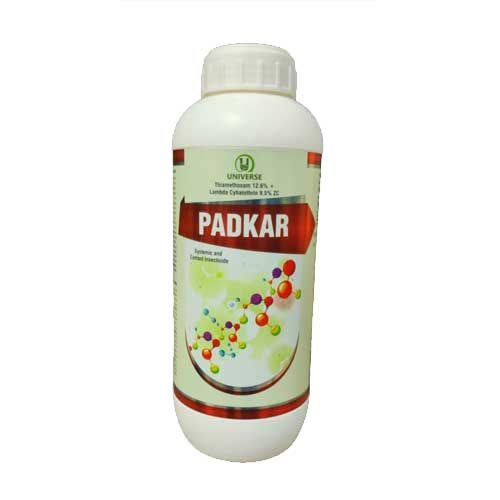
Thiamethoxam 12.6% + Lambda-cyhalothrin 9.5% ZC is a combination insecticide having quick stomach and contact activity and is recommended to control Aphids, jassids, Thrips & Bollworms in Cotton, Aphid, shootfly, steam borer in Maize, Leaf hopper, leaf eating caterpillars in Groundnut, Stem fly, semilooper, girdle beetle in Soyaben, Thrips & fruit borer in Chilli, Thrips, semilooper, tea mosquito bug in Tea, Thrips, whiteflies, fruit borer in Tomato crop.
| Crop(s) | Common Name of Pest | Dosage/HA | Dilution in Water (L) | Waiting Period between last spray to harvest (in days) |
Re-entry after each Applicatio n (In Hours) | |
| AI (g) |
Formulation (ml) | |||||
| Cotton | Aphids, jassids, Thrips & Bollworms | 44 | 200 | 500 | 26 | |
| Tea | Thrips, semilooper, tea mosquito bug | 33 | 150 | 500 | 1 | |
| Tomato | Thrips, whiteflies, fruit borer | 27.5 | 125 | 500 | 5 | |
| Maize | Aphid, shootfly, steam borer | 27.5 | 125 | 500 | 42 | |
| Chilli | Thrips & fruit borer | 33 | 150 | 500 | 3 | |
| Groundnut | Leaf hopper, leaf eating caterpillars | 27.5 | 125 | 500 | 28 | |
| Soyaben | Stem fly, semilooper, girdle beetle | 27.5 | 125 | 500 | 48 | |
Measure out required quantity of the product and mix it well with a small quantity of water. Add the remaining quantity of water as specified through agitation for total coverage of crop with suitable sprayers.
The product should not be applied during flowering of the crop. DO NOT use the product where bees are actively foraging. DO NOT allow spray drift to flowering weeds, hedges or flowering crops in the vicinity of the treatment area. DO NOT spray if a high amount of aphid honeydew is present in the treatment area. DO NOT spray on flowering crops between 5 days before start of flowering and end of flowering. Not to be used on crops when honey bees are pollinators / foraging. This product is also toxic to fish
Do not use cooking utensils for preparing sprays. Use stick for stirring the spray solution. Wear hand gloves to avoid contact with the skin. Also avoid inhalation and contact with eyes. Wear protective clothing, mask, goggles, boots, while spraying and do not expose yourself to spray drift. Do not blow nozzles with mouth. Do not eat, drink or smoke while handling or applying the product. Do not store unused spray solution. Clean sprayers, buckets and other utensils with water daily after use. Wash hands with soap and plenty of water and change clothes after the work is over. Also wash the contaminated clothes. DO NOT allow spray to drift onto rivers, lakes, ponds, ditches or other waterways. DO NOT allow discharging left over spray material or empty containers to contaminate waterways.
Poisoning symptoms in rodents are non-specific, may cause symptoms of ataxia, salivation, lachrymation and decreased breathing etc.
Remove the affected person from the danger zone to a well-ventilated room or to fresh air and protect from under cooling.
IN CASE OF SUSPECTED POISONING: Immediately call a physician.
IN CASE OF SKIN CONTACT: remove contaminated clothing and thoroughly wash the affected parts of the body with soap and water.
IN CASE OF EYE CONTACT: Rinse eyes with clean water for several minutes and immediately call a physician.
IN CASE OF INGESTION: Repeatedly administer medicinal charcoal in a large quantity of water.
NOTE: Never give anything by mouth to an unconscious person. Do not induce vomiting.
As in comman.
No specific antidote is known. Apply symptomatic therapy.